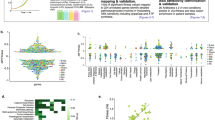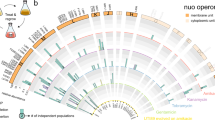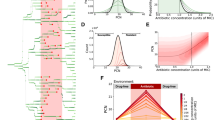Abstract
Bacteria show remarkable adaptability in the face of antibiotic therapeutics. Resistance alleles in drug target-specific sites and general stress responses have been identified in individual end-point isolates1,2,3,4,5,6,7. Less is known, however, about the population dynamics during the development of antibiotic-resistant strains. Here we follow a continuous culture of Escherichia coli facing increasing levels of antibiotic and show that the vast majority of isolates are less resistant than the population as a whole. We find that the few highly resistant mutants improve the survival of the population’s less resistant constituents, in part by producing indole, a signalling molecule generated by actively growing, unstressed cells8. We show, through transcriptional profiling, that indole serves to turn on drug efflux pumps and oxidative-stress protective mechanisms. The indole production comes at a fitness cost to the highly resistant isolates, and whole-genome sequencing reveals that this bacterial altruism is made possible by drug-resistance mutations unrelated to indole production. This work establishes a population-based resistance mechanism constituting a form of kin selection9 whereby a small number of resistant mutants can, at some cost to themselves, provide protection to other, more vulnerable, cells, enhancing the survival capacity of the overall population in stressful environments.
This is a preview of subscription content, access via your institution
Access options
Subscribe to this journal
Receive 51 print issues and online access
$199.00 per year
only $3.90 per issue
Buy this article
- Purchase on Springer Link
- Instant access to full article PDF
Prices may be subject to local taxes which are calculated during checkout




Similar content being viewed by others
References
Albert, T. J. et al. Mutation discovery in bacterial genomes: metronidazole resistance in Helicobacter pylori . Nature Methods 2, 951–953 (2005)
Smith, B. T. & Walker, G. C. Mutagenesis and more: umuDC and the Escherichia coli SOS response. Genetics 148, 1599–1610 (1998)
Bjedov, I. et al. Stress-induced mutagenesis in bacteria. Science 300, 1404–1409 (2003)
Miller, J. H. Spontaneous mutators in bacteria: insights into pathways of mutagenesis and repair. Annu. Rev. Microbiol. 50, 625–643 (1996)
Friedman, L., Alder, J. D. & Silverman, J. A. Genetic changes that correlate with reduced susceptibility to daptomycin in Staphylococcus aureus. Antimicrob. Agents Chemother. 50, 2137–2145 (2006)
Kohanski, M. A., DePristo, M. A. & Collins, J. J. Sublethal antibiotic treatment leads to multidrug resistance via radical-induced mutagenesis. Mol. Cell 37, 311–320 (2010)
Wang, H., Dzink-Fox, J. L., Chen, M. & Levy, S. B. Genetic characterization of highly fluoroquinolone-resistant clinical Escherichia coli strains from China: role of acrR mutations. Antimicrob. Agents Chemother. 45, 1515–1521 (2001)
Gooder, H. & Happold, F. C. The tryptophanase-tryptophan reaction; the nature of the enzyme-coenzyme-substrate complex. Biochem. J. 57, 369–374 (1954)
West, S. A., Griffin, A. S., Gardner, A. & Diggle, S. P. Social evolution theory for microorganisms. Nature Rev. Microbiol. 4, 597–607 (2006)
Woodford, N. & Ellington, M. J. The emergence of antibiotic resistance by mutation. Clin. Microbiol. Infect. 13, 5–18 (2007)
Livermore, D. M. Bacterial resistance: origins, epidemiology, and impact. Clin. Infect. Dis. 36 (suppl. 1). S11–S23 (2003)
Smith, P. A. & Romesberg, F. E. Combating bacteria and drug resistance by inhibiting mechanisms of persistence and adaptation. Nature Chem. Biol. 3, 549–556 (2007)
Hirakawa, H., Inazumi, Y., Masaki, T., Hirata, T. & Yamaguchi, A. Indole induces the expression of multidrug exporter genes in Escherichia coli . Mol. Microbiol. 55, 1113–1126 (2005)
Kobayashi, A., Hirakawa, H., Hirata, T., Nishino, K. & Yamaguchi, A. Growth phase-dependent expression of drug exporters in Escherichia coli and its contribution to drug tolerance. J. Bacteriol. 188, 5693–5703 (2006)
Lee, J. H. & Lee, J. Indole as an intercellular signal in microbial communities. FEMS Microbiol. Rev. 34, 426–444 (2010)
Travisano, M. & Lenski, R. E. Long-term experimental evolution in Escherichia coli. IV. Targets of selection and the specificity of adaptation. Genetics 143, 15–26 (1996)
Altuvia, S., Weinstein-Fischer, D., Zhang, A., Postow, L. & Storz, G. A small, stable RNA induced by oxidative stress: role as a pleiotropic regulator and antimutator. Cell 90, 43–53 (1997)
Dwyer, D. J., Kohanski, M. A., Hayete, B. & Collins, J. J. Gyrase inhibitors induce an oxidative damage cellular death pathway in Escherichia coli . Mol. Syst. Biol. 3, 91 (2007)
Kohanski, M. A., Dwyer, D. J., Hayete, B., Lawrence, C. A. & Collins, J. J. A common mechanism of cellular death induced by bactericidal antibiotics. Cell 130, 797–810 (2007)
Kohanski, M. A., Dwyer, D. J., Wierzbowski, J., Cottarel, G. & Collins, J. J. Mistranslation of membrane proteins and two-component system activation trigger antibiotic-mediated cell death. Cell 135, 679–690 (2008)
Tucker, N. P., Le Brun, N. E., Dixon, R. & Hutchings, M. I. There’s NO stopping NsrR, a global regulator of the bacterial NO stress response. Trends Microbiol 18, 149–156 (2010)
Mouneimné, H., Robert, J., Jarlier, V. & Cambau, E. Type II topoisomerase mutations in ciprofloxacin-resistant strains of Pseudomonas aeruginosa. Antimicrob. Agents Chemother. 43, 62–66 (1999)
Miller, P. F., Gambino, L. F., Sulavik, M. C. & Gracheck, S. J. Genetic relationship between soxRS and mar loci in promoting multiple antibiotic resistance in Escherichia coli . Antimicrob. Agents Chemother. 38, 1773–1779 (1994)
Long, F., Rouquette-Loughlin, C., Shafer, W. M. & Yu, E. W. Functional cloning and characterization of the multidrug efflux pumps NorM from Neisseria gonorrhoeae and YdhE from Escherichia coli . Antimicrob. Agents Chemother. 52, 3052–3060 (2008)
Baba, T. et al. Construction of Escherichia coli K-12 in-frame, single-gene knockout mutants: the Keio collection. Mol. Syst. Biol. 2, 2006.0008 (2006)
Steiling, K. et al. Comparison of proteomic and transcriptomic profiles in the bronchial airway epithelium of current and never smokers. PLoS ONE 4, e5043 (2009)
Lee, J., Jayaraman, A. & Wood, T. K. Indole is an inter-species biofilm signal mediated by SdiA. BMC Microbiol. 7, 42 (2007)
Talloen, W. et al. I/NI-calls for the exclusion of non-informative genes: a highly effective filtering tool for microarray data. Bioinformatics 23, 2897–2902 (2007)
Bentley, D. R. et al. Accurate whole human genome sequencing using reversible terminator chemistry. Nature 456, 53–59 (2008)
Herring, C. D. et al. Comparative genome sequencing of Escherichia coli allows observation of bacterial evolution on a laboratory timescale. Nature Genet. 38, 1406–1412 (2006)
Acknowledgements
We thank M. Chaparian and Q. Beg for help with bioreactor instrumentation. We also thank A. Herbert and C. Ordija for use of the Covaris sonicator for preparing sequencing libraries. This work was supported by the National Institutes of Health through the NIH Director’s Pioneer Award Program, grant number DP1OD003644; the National Science Foundation through RTG grant number DMS-0602204; and the Howard Hughes Medical Institute.
Author information
Authors and Affiliations
Contributions
All authors designed the study. H.H.L. and M.N.M. performed and analysed the experiments with input from C.R.C. and J.J.C. All authors prepared and commented on the manuscript.
Corresponding author
Ethics declarations
Competing interests
The authors declare no competing financial interests.
Supplementary information
Supplementary Information
This file contains Supplementary Figure 1 with legend, Supplementary Methods and Supplementary Table 1. (PDF 285 kb)
Supplementary Tables
This file contains Supplementary Table 2 (XLS 657 kb)
Rights and permissions
About this article
Cite this article
Lee, H., Molla, M., Cantor, C. et al. Bacterial charity work leads to population-wide resistance. Nature 467, 82–85 (2010). https://doi.org/10.1038/nature09354
Received:
Accepted:
Issue Date:
DOI: https://doi.org/10.1038/nature09354
This article is cited by
-
Spatial transcriptome uncovers rich coordination of metabolism in E. coli K12 biofilm
Nature Chemical Biology (2023)
-
Fragmentation and [4 + 3] cycloaddition in sodorifen biosynthesis
Nature Chemistry (2023)
-
Unusual Evolution of Cephalopod Tryptophan Indole-Lyases
Journal of Molecular Evolution (2023)
-
Dynamic altruistic cooperation within breast tumors
Molecular Cancer (2023)
-
From the soil to the clinic: the impact of microbial secondary metabolites on antibiotic tolerance and resistance
Nature Reviews Microbiology (2022)
Comments
By submitting a comment you agree to abide by our Terms and Community Guidelines. If you find something abusive or that does not comply with our terms or guidelines please flag it as inappropriate.



